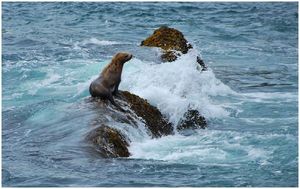Physical Appearance
The Steller sea lion also known as the norther sea lion is sometimes confused with the California sea lion. However, the Steller sea lion is much larger, males weighing almost 2,500 pound and measuring 11 feet and females weighing 1,000 pounds and measuring 9 feet. They are also lighter in color then California sea lions. Their fur is light tan to reddish brown. Finally the bony sagittal crest that is present on the tops of the heads of the California sea lions is not present in the Steller sea lions. The name sea lion comes from their thick necks that some find to resemble a lion’s mane. The Steller sea lion has a blunt face and boxy head.
Life Cycle
In May the male steller sea lions gather on rookeries and establish dominance. Shortly thereafter the females arrive. Offspring that have not yet become sexually mature will sometimes accompany their mothers. The female sea lions will first give birth to the offspring they’ve been carrying since the previous year. One or two weeks later they will then mate with one or more of the dominant males. Steller sea lions have what is called delayed implantation. Although the act of breeding occurs in May the fertilized egg will not be implanted and begin to develop into a fetus until the fall. After breeding the females will continue to nurse their pups on the rookery (breeding area) until later summer when they will return to the sea together.
Diet
The steller sea lion will feed on many different species of fish and cephalopods. Examples of their common prey include but are not limited to walleye pollock, Atka mackerel, Pacific salmon, herring, capelin, Pacific cod, rockfish, squid and octopus. Steller sea lions are part of the diet of killer whales and great white sharks.
Habitat
The habitat of the steller sea lion stretches from central California to Japan throughout an are called the North Pacific Rim. They spend most of their time out to sea rarely coming to shore except during the breeding season.
Conservation Status
The steller sea lion is listed as endangered on the IUCN (International Union of Conservation of Nature and Natural Resources) red list of endangered species. Just the California population has dropped 80% in the last 30 years and is now at a mere 500. Experts are not entirely sure of the reason but believe it has to do with the fish they eat being scarce as a result of big commercial fisheries in the Gulf of Alaska. Other possible contributing causes are drowning, entanglement in nets and gunshot. The steller sea lion is protected by both the Marine Mammals Protection Act and the Endangered Species Act. With these acts forbidding the killing, harming, harassment or hunting of this species a recovery of steller sea lions looks hopeful.
References:
http://www.marinemammalcenter.org/learning/education/pinnipeds/stellersea.asp
http://en.wikipedia.org/wiki/Steller_Sea_Lion



